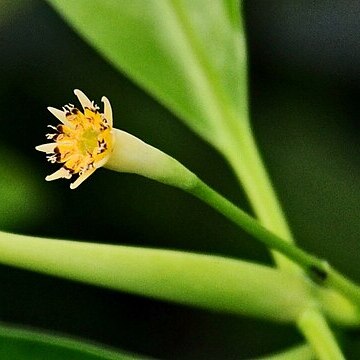Tree to 20 m high; knee roots abundant; bark smooth, grey. Leaves elliptic, acute; lamina 4–13 cm long, 2.5–4 cm wide; petiole 1.5–2 cm long; stipules c. 4.5 cm long. Inflorescence 3–10-flowered; peduncle c. 2 cm long; pedicels 6–13 mm long; flowers yellow-green. Hypanthium 7–9 mm long, slightly or distinctly ribbed. Sepals usually 8, c. 2 mm long, erect in fruit. Petals 1.5–2 mm long, bearded outside near base; lobes c. 0.5 mm long; terminal bristles 3 on each lobe and 1 in sinus, about as long as lobes. Anthers oblong, distinctly shorter than filaments. Fruit 1–2 cm long. Hypocotyl 7–20 cm long, c. 5 mm wide, not ribbed, falling with fruit attached; fruit wall persistent as a collar on seedling, the sepals pointing downwards.
A straight growing tree of medium size. It reaches 35 m high. The trunk is straight and up to 30 cm across. The bark is smooth and grey with white blotches. It can have buttresses up to 1 m high and has knee shaped aerial roots. The leaves are in tufts at the end of the upward bending twigs. The leaves are dull or yellowish green, long and tapering at both ends. They are 4-11 cm long by 2-4 cm wide. The leaf stalk is less than 2.5 cm. The flowers are in groups of 2-5 on stalks in the axils of leaves. The flowers are small being 0.3 cm across. The fruit is long, about 1.5-3 cm and with 8 tiny teeth clasping the slender (10-20 cm) long hypocotyl.


